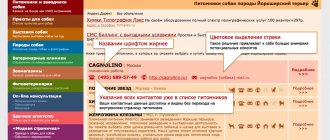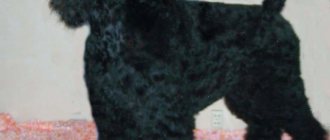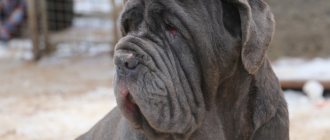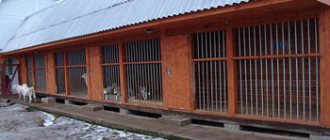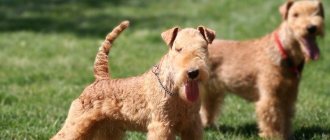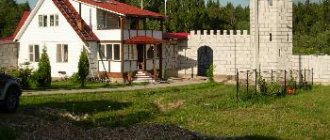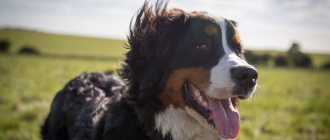- Pets
- >>
- Dog breeds
* Here is a photo of a typical representative of the Pyrenean mountain dog breed . You can send us photos of your animals by email, and we will post them on the website. Don't forget to send your pet's name.
Video
* We invite you to watch a video about the Pyrenean Mountain Dog . In fact, in front of you is a playlist in which you can select and watch any of 20 videos about a given dog breed by simply clicking on the button in the upper right corner of the window. In addition, the material contains quite a lot of photos. By looking at them you can find out what a Pyrenees Mountain Dog looks like.
In this article:
|
History of the origin of the Pyrenean mountain dogs
This breed of dog was bred to protect houses and livestock in mountainous areas, and in terms of its qualities, Pyrenean mountain dogs can compete with breeds such as the Central Asian Shepherd Dog or Tibetan Mastiff. Thick fur protects these dogs from the cold and bites of large predators, which they were excellent at dealing with. Due to their endurance, these dogs were also used as carrier animals.
How these dogs got into the Pyrenees Mountains is still unknown. Some experts believe that the Pyrenean mountain dog is one of the oldest breeds that arose in Europe back in 1800 BC, and maybe earlier. There is also an opinion that the dog originates from Asia, where the breed was formed.
Interesting fact: The Pyrenean Mountain Dog was highly valued not only by peasants, who used it to herd animals and protect property. These dogs were also appreciated by rich people, who placed such dogs to guard rich mansions. In 1675, this dog breed even received official recognition among the courtiers.
Only towards the end of the 19th century did Pyrenean dogs come to America, where they received the well-deserved attention of many breeders. From there, the story of the growing popularity of this breed began: in the 20th century, the first exhibitions began to be held. During the First and Second World Wars, Pyrenean dogs provided significant assistance to soldiers, dragging the wounded from the battlefield and transporting valuable ammunition and cargo.
In the 20th century, serious work was underway to restore the Pyrenean dog breed. Today, their numbers are stable, and they continue to be popular among breeders.
Gampr (Armenian wolfhound)
- Origin: Armenia
- Height: from 58 to 66 cm
- Weight: from 45 to 61 kg
- Life expectancy: 12 to 15 years
- Temperament: intelligent, strong-willed, relatively independent, courageous
The Gampr is an old breed of large to gigantic dog that began to evolve in the Armenian Highlands as a livestock protector thousands of years ago. These dogs are naturally caring and affectionate with both livestock and family members of any age, but they can be more serious and aloof than most breeds and are not playful . Although gampras are intelligent, courageous, and generally calm, they do not get along well with other animals unless they receive significant socialization.
Numerous carvings and engravings of dogs have helped trace the history of the breed, and by 1000 BC, most of these petroglyphs appear to be dedicated to Gampras, indicating that the breed was not only well known by this time, but was also preferred.
Did you know that after the invasion of the Ottoman Empire, the number of these powerful dogs decreased sharply, but, on the other hand, they became more widespread. They were even used as the basis for creating various Turkish breeds. And thanks to them, the Caucasian Shepherd appeared in the Soviet Union.
Gampras evolved as guards, protecting livestock from large predators. Only a big and strong dog can cope with such opponents. The Armenian Gampr is just like that: muscular, with a long, straight back and pronounced shoulder blades. Dogs still used as livestock protectors often have their ears cropped , as this prevents large predators from biting and holding their ears, gaining an advantage.
This breed has a two-layer coat consisting of a thick undercoat and a coarse outer coat that protects against both the elements and predators. Their coats contain protective oils that help shed dirt and debris and also protect the skin, so bathing should only be done a few times a year as needed, and weekly brushing with a rake will usually prevent large clumps from forming.
IMPORTANT! These dogs are known to grow slower than others and may benefit from a diet designed for large breed puppies until their growth slows.
Although the Armenian Gampr is not an overly energetic animal, it is a working dog breed and requires a moderately high level of exercise to stay healthy. This is a very large breed of dog, so exercise that puts stress on the joints, such as jumping, long runs and even climbing stairs, should be kept to a minimum, especially while the pet is still growing. This will help avoid bone and joint problems as your dog gets older. A long daily walk is excellent exercise for these dogs, and since they are most active at dawn and dusk, this may be the best time for walks.
Pyrenean Mountain Dog - description of the breed
Pyrenean mountain dogs are similar in appearance to wolf-like dogs of ancient breeds. For centuries, people have selected the largest puppies with the lightest fur so that it would be visible among dense vegetation. Also, white dogs were different from wolves, so shepherds did not confuse dogs with predators in the dark, and could also shoot wolves during a fight with a dog.
Pyrenean dogs have a large body and high height - from 75 cm. The weight of such dogs can reach 55 kg, but the dog does not look bulky. These dogs are quite elegant and easy to walk.
According to the standard, dogs should have a round skull, not massive, with a pronounced occiput. The length of the skull should be equal to the muzzle. The muzzle is wedge-shaped, the transition to the forehead is smooth, without a clear bend. These dogs have almost no brow ridges and cheekbones, and their cheeks are almost unpronounced.
The eyes of the Pyrenees Mountain Dog are small, almond-shaped and wide set. The color of the iris can be all shades of brown, up to almost black. The eyelids cover the eyeball well, but are not clearly expressed due to the dark color. Thanks to this, the dog’s gaze is considered conscious and attentive.
Pyrenees dogs have small, triangular-shaped ears that are set quite low. The tips of the ears are not sharp, but rounded, reaching the corners of the eyes. The fur on the top and bottom of the muzzle forms a convergence that extends to the base of the ear.
These dogs have a scissor or straight bite. Strong white teeth slightly tilted inward. The lips tightly cover the teeth and are black in color, as is the nose. The elongated body of such dogs looks overly elongated, more in length than in height. Pyrenean dogs have a straight, strong back with a low tail and a pronounced croup. The paws are strong, the joints are visible.
Popular colors of Pyrenees mountain dogs
The coat of the Pyrenees Mountain Dog is unique in its structure. Below there is a thick undercoat, dense, but very soft, pleasant to the touch. It is not long, so it is completely covered with a top layer of wool. The guard hair is straight, sometimes curls a little, but not curly.
The top layer of hair is very long and hard. The thick fur on the back of the hind legs forms something similar to pants, and a headband resembling a lion's mane grows around the neck. The tail is also covered with long hair, which becomes shorter towards the end. The muzzle and ears are covered with a smooth short coat. The thick coat of the Pyrenees Mountain Dog is self-cleaning, making this breed easy to keep.
Colors of the Pyrenean Mountain Dog:
- The most popular color is snow white. It is he who is valued among breeders as the most noble. Dogs with snow-white fur have the greatest chance of winning at a show;
- Colors with fawn and light beige spots on the body are allowed. The spots must be very large and barely visible. They do not take up more than a third of the white space on the dog;
- Darker spots are not allowed by all cynological organizations, but they do occur. These are light gray, reddish and badger spots that are located on the head or tail.
Caucasian Shepherd Dog (Caucasian Mountain Dog, Caucasian Wolfhound)
- Origin: Caucasus
- Height: from 67 to 70 cm
- Weight: from 50 to 100 kg
- Life expectancy: 10 to 12 years
- Temperament: strong, alert, dominant, calm, playful
The Caucasian Shepherd is a strong and athletic dog with strong muscles and strong bones. It has a large wedge-shaped head and a thick, curved tail. The breed is often recognized by its dark mask on the face against a background of thick fur in shades of gray, fawn or red with white markings.
The Caucasian Shepherd Dog is an ancient dog breed originating from the Caucasus region of Eastern Europe, where it was used to guard and protect herds, flocks and villages from predators and intruders. Research shows that the Caucasian Shepherd Dog is a close relative of the Balkan Shepherd Dogs and Asian Mastiffs. Since the 1920s, Caucasian Shepherd Dogs have selectively developed such valuable qualities as strength, confidence, courage, endurance, keen hearing and vision. The breed was recognized by the United Kennel Club in 1995.
The brave, energetic and strong-willed Caucasian Shepherd quickly defends its family and property. She is territorial towards strangers and other dogs, but is also gentle and kind towards her human family. A stable and even-tempered Caucasian Shepherd requires proper socialization and patient training to avoid any potential aggression.
The thick double coat of the Caucasian Shepherd can range from short to very long. Those with longer hair should be brushed daily, while short-haired dogs should be brushed weekly. In addition, they should regularly trim their nails and clean their ears and teeth.
The Caucasian Shepherd is a calm breed with relatively low energy, but it enjoys daily walks or outdoor play and has enough stamina to endure long walks or hikes. Walking on a leash and free play in a large fenced yard are best for this intelligent and independent breed . The Caucasian Shepherd, although active outdoors, is quiet inside the house.
Character and habits of Pyrenean mountain dogs
Pyrenean mountain dogs are distinguished by exclusively positive qualities: kindness, patience, sharp intelligence and devotion to their owners. These large dogs have not lost their guarding qualities and still show a penchant for herding work. Despite this, Pyrenean dogs are excellent companions.
These dogs, due to their patience, love children, allowing them to ride on their backs. Even adult dogs can support children in playing with them, but at the same time they will not allow the child to get into trouble by vigilantly monitoring his movements. Pyrenean dogs are even used for the psychological rehabilitation of children who have developmental disorders.
Dogs also get along well with other pets, including cats. A well-mannered and intelligent dog will never touch someone who does not interfere with him or his owners. They do not show unreasonable aggression, on the contrary, demonstrating a balanced character. But due to their protective qualities, these dogs are always wary of strangers.
Interesting fact: When a stranger comes to visit, these dogs show increased interest in him, trying to sniff him. This way the dog makes sure that the stranger is not a threat to the owners, and then may even allow himself to be petted. But throughout the stay of strangers in the house, the dog will keep an eye on them.
Pyrenean dogs are good watchdogs. They faithfully guard the territory of the home and family members. The barking of these dogs and their menacing appearance can scare away any intruders. Although these dogs are not stubborn, they can sometimes show excessive independence, making decisions without the knowledge of their owners. For example, if a dog senses danger, he may leave the house to eliminate it.
In general, dogs are independent in making decisions, do not tolerate aggression towards themselves, but are ready to endure a lot from their owners.
Akbash
- Origin: Turkey
- Height: from 69 to 86 cm
- Weight: from 41 to 64 kg
- Life expectancy: 10 to 11 years
- Temperament: intelligent, loyal, independent, fearless
The Akbash is an ancient breed that originated in the plains and mountains of western Turkey, where it was bred by villagers and shepherds to protect livestock from wolves and other predators. Although the Akbash is the Turkish counterpart to other white guard dog breeds found in the northern Mediterranean basin, it is the only breed that has a distinct combination of mastiff and hound characteristics .
Like other hounds, the Akbash is distinguished by long limbs, a deep chest and a tucked belly. The influence of the Mastiff breed is evident in height, weight, broad head and powerful body. The wedge-shaped head is adorned with floppy ears, and the long tail curls behind the back when moving or excited.
This white, lean, muscular dog has a wary gaze and a regal appearance that conveys all its power, strength and courage. Akbash also has the speed and agility it needs to fight and chase predators.
Akbash can be both a domestic companion and a guard dog. He is calm, quiet, independent and balanced. Akbash is loyal, affectionate and attached to his human family, children and other pets. He is naturally wary and suspicious of strangers and can be territorial towards other dogs. This dog takes well to training and must be properly socialized from an early age to become a good family dog.
This white dog breed's medium to long coat, which may have a slight biscuit or gray tint around the ears or undercoat, should be brushed weekly to remove dirt and loose hair. Periodic bathing, regular teeth brushing and nail trimming are also among the breed's basic grooming needs. Although the Akbash's activity level is relatively low, this pet is best suited to homes with a large fenced yard that provides it with plenty of room to run around.
Interesting facts about Pyrenees mountain dogs
The Pyrenean Mountain Dog breed dates back about four thousand years, and during this time the breed has acquired many interesting qualities. It is reliably known that dogs of this breed were companions of shepherds who lived on the border of France and Spain. There is even evidence from documents that these dogs lived next to ancient people.
Over its long history, the dog has distinguished itself by many facts:
- Pyrenean dogs can stay awake for a long time. Originally it was necessary for them to guard the herds at night, but now that guarding is no longer required, the dog still retains this quality;
- These dogs are considered the royal dogs of France. This is one of the few examples when a working peasant dog came into use by the nobles due to its irreplaceable qualities;
- Louis XIV declared these dogs royal because he loved this breed very much;
- Queen Victoria, who generally loved dogs, received a Pyrenean puppy as a gift;
- The Marquis de Lafayette brought Pyrenean Mountain Dogs from Europe to America back in 1824, and the breed has still been growing in popularity since then;
- During the Second World War, almost all representatives of the breed were destroyed. They were indispensable in transporting heavy ammunition along mountain paths among the Alps;
- The restoration of the breed began in the 20th century, and the largest part of it was farmers who preserved these dogs;
- Pyrenean dogs influenced the development of the Saint Bernard breed, which almost became extinct in an epidemic in 1870 in the Alps.
Pros and cons of Pyrenees mountain dogs
The Pyrenean Mountain Dog has a number of advantages over other breeds.
These include:
- Unquestioning devotion to the owner;
- Smart, good learning ability. Dogs of this breed love to serve people, so they are willing to train;
- Excellent security qualities. Pyrenean mountain dogs are natural guardians, and they will defend their territory to the end;
- These dogs are peaceful, so you don’t have to be afraid that they will show aggression towards people for no reason;
- Independence. Often they can be left to their own devices, and the dog will not feel discomfort from this. Also, in emergency situations, these dogs are able to make decisions independently.
But this breed of dog also has a number of disadvantages. In addition to the enormous size, due to which the dog will not fit in the apartment.
These include:
- The need for proper training. A dog can be uncontrollable and dangerous if not handled;
- Careful care of the coat so that it does not get tangled;
- If a dog of this breed becomes aggressive, it will be difficult to retrain it;
- These dogs have only one leader, whose commands they will follow. Other people in the family are simply members of the pack;
- These dogs also need good and regular physical exercise.
Anatolian Shepherd (Kangal)
- Origin: Turkey
- Height: from 63 to 80 cm
- Weight: from 40 to 60 kg
- Life expectancy: 11 to 13 years
- Temperament: sensitive, independent, alert, protective, calm
The Kangal is a large, powerful, strong dog with great endurance and agility. This breed's coat consists of a thick undercoat and an outer coat that is slightly longer on the neck and mane. The Anatolian Shepherd gives the impression of being a brave but calm protector.
The Anatolian Shepherd is an ancient breed with a long working history. The dog's roots probably go back to the Tibetan mastiff and Roman war dogs that came to Turkey more than 4,000 years ago. Here they were valued as hardy protectors of livestock from formidable predators, including wolves and bears. Kangals accompanied nomadic shepherds and became widespread, which explains the large differences between Anatolian Shepherds in size, coat type and color. However, some traits that have remained constant throughout the breed are loyalty, independence and endurance.
Did you know that the Turkish name for this breed - koban kopegi - means herding dog .
This is a calm and loyal breed of dog that will never back down when in danger. Kangals are suspicious of strangers and are territorial. Although they are good with children, they may not be playful enough for them.
The Anatolian Shepherd needs the opportunity to exercise every day, whether it's a long walk or a fast run, and it needs the companionship of its family. Grooming is minimal and consists only of weekly brushing.
Breeding Pyrenean Mountain Dogs
Breeding a Pyrenees Mountain Dog is a complex undertaking that requires strict rules. This is the only way to obtain viable offspring that comply with the standard. To breed this breed, you should first obtain advice from specialists who have already done this. Choose reputable breeders.
A male who is ready for mating must be in excellent physical shape. The dog must be exposed to physical activity, eat properly, and have high muscle mass. Males are selected for their size, as well as for their character traits: calmness, poise, and obedience are important.
The first mating of a bitch should not occur earlier than the age of two. She must go through at least three heats - only then the dog is ready to bear offspring and subsequent births. An immature dog’s body can lead to the death of puppies and the adult itself. Also, mating too early can affect the quality of the offspring. A bitch should not give birth more than once a year.
For breeding, choose an animal without hereditary diseases and with all the necessary vaccinations. All features of the breed must be expressed in both parents: elongated body, narrow head, low-set tail, etc. It is better to introduce the bitch and the dog to each other in advance so that they do not get nervous when they meet.
Caring for Pyrenean Mountain Dogs
Dogs of this breed do not require special care, but in order for their thick and long coat to look well-groomed and beautiful, they need to be looked after. Ideally, the dog should be brushed every day, but some breeders do this two or three times a month if the dog lives outside year-round and performs official duties.
Important fact: During the shedding period, the dog is brushed several times a day, otherwise there is a risk of getting hard tangles.
It is harmful to wash dogs too often - it dries out their skin and damages their coat. It is better to use special shampoos with a whitening effect, especially if the dog is a show specimen. With the help of such shampoos you can get rid of the yellowness that occurs with age around the eyes, on the paws and on the stomach. In fact, bathing is not difficult, since Pyrenean mountain dogs never refuse to swim.
The rest of the care is standard. It is necessary to brush your teeth, keep your eyes and ears clean, and trim your nails to prevent dirt from getting under them. Some breeders trim the hair under the tail to prevent it from getting dirty.
Care also includes the following classic procedures:
- Inspect the fur for ticks after a walk;
- Treatment for skin and internal parasites;
- Vaccination.
Content Features
Keeping a Pyrenean mountain dog in a city apartment or on a chain is not suitable. She needs space where she can run, a large territory that she will protect. It is not recommended to close the enclosure for a long time; communication with a person is advisable. Dog handlers recommend not limiting the freedom of this dog - it should be able to enter the house at any time.
Be sure to make a strong, high fence in the area where the Great Pyrenees lives. This dog can make a dig or jump over a low fence, and quickly understands how to lower the handle to open the gate. An insulated booth is also needed, where he can hide in hot weather or frost. You can let the dog into the house at night or leave it outside - they calmly tolerate it.
Even with this method of keeping, you need to walk your pet twice a day. It is advisable to take him to the dog park, where he can play and frolic. The Pyrenees will happily accompany its owner on runs or bike rides.
These dogs do not need special care. You need to check and wipe your pet’s ears every week and remove discharge from the eyes. Trim the nails approximately once a month, not forgetting the dewclaws.
Grooming
The coat of the Great Pyrenees requires careful grooming. It needs to be combed 3-4 times a week to prevent tangles from forming. Particular attention should be paid to areas behind the ears, abdomen, and limbs. During the molting period, this must be done daily. This dog sheds a lot, although only once a year.
For combing you will need combs with fine and rare teeth, brushes, a furminator, a slicker, and a tangle cutter. It is recommended to shorten the hair between the toes, in the groin, and under the tail. This will make it easier to keep clean.
The peculiarity of the coat of these dogs is that dirt does not stick to it, and it does not smell like a dog. Therefore, they do not need frequent washing, once every 2-3 months is enough. It is necessary to use a special shampoo for long-haired dogs. To maintain the whiteness of the coat, it is advisable to choose one that is designed for that color. Conditioners will also be needed to make combing easier. In summer you can bathe your dog in open water; Pyrenees love to swim.
Nutrition
You can feed this dog dry food or natural food. A puppy should eat 3-5 times a day, an adult dog - in the morning and evening. With natural feeding, at least 2/3 of the diet should be protein products. This is lean meat, sea fish, offal, eggs, cottage cheese. It is useful to give fermented milk products, cheese, herbs, and raw vegetables.
The meat can be mixed with a small amount of porridge - buckwheat, rice or oatmeal. Although veterinarians recommend giving porridge only in winter, when the dog needs more energy. You need to add vegetable oil, yeast, bran, fish oil, and vitamin complexes to your food.
Sweets, smoked foods, fatty and salty foods are prohibited for Pyrenean dogs. Potatoes, corn, and baked goods should not be given. Some foods can turn wool a rusty color. Veterinarians believe that this occurs due to the large amount of copper in the diet. Food allergies are also common, leading to dermatitis and brown spots under the eyes.
If you feed your pet dry food, you need to choose super-premium brands. They should be designed for giant breeds with average activity. The composition should have a high protein content and a minimum of carbohydrates. It is difficult for these dogs to choose the right food: they may be difficult to digest or may stain their coat. But many owners prefer this method of feeding, since it is easier to determine the amount of food and there is no need to give additional vitamins.
The Great Pyrenees should not be overfed, especially at an early age. These dogs have a slow metabolism, so weight accumulates quickly. Normally, the puppy's ribs should be clearly palpable. If you have excess body weight, there is a risk of developing pathologies of the musculoskeletal system. For an adult dog, the volume of food should be approximately 700-800 g at a time or 20 g per 1 kg of weight. But in determining the daily nutritional intake, you need to take into account the time of year, physical activity and the conditions under which the dog is kept.
It is recommended to feed your Pyrenean Shepherd after a walk. If the dog moves actively on a full stomach, he may experience intestinal volvulus. The bowl should be placed on a stand at chest level. The dog should always have clean water freely available.
Health
The Pyrenees Mountain Dog is adapted to work in harsh conditions. She is hardy, has good health, strong immunity. But all the same, the pet requires timely vaccination, deworming, and preventive examinations by a veterinarian. Life expectancy, like most large breeds, is about 12 years. With good care, these dogs live up to 15 years.
Sometimes the Pyrenees develop the following diseases:
- joint dysplasia;
- dermatitis;
- inflammation of the ears;
- volvulus;
- depression and nervous disorders when living in a confined space.
Diet of Pyrenees Mountain Dogs
Large dogs need the most nutritious and balanced food possible. These dogs are not picky about food, but the diet must be selected in accordance with natural food. Of course, premium ready-made food for large breeds is suitable, but homemade food is preferable for this breed. It should contain about 30 percent fat and carbohydrates, and 70 percent protein.
The diet of the Pyrenees Mountain Dog includes the following essential components:
- Raw meat. You can also serve it boiled, but occasionally – it is poorly digested by these dogs. It is worth giving preference to lean foods such as chicken, turkey, duck, rabbit, veal and lean lamb;
- Sea oily fish. It is strictly forbidden to give river water;
- A boiled egg is given two to three times a week, which gives dogs an important dose of protein and calcium;
- Lots of greens and vegetables: lettuce, cabbage, carrots, cucumbers. This will provide your mountain dog with fiber;
- Apples, pears, bananas, processed into puree, can be given once a week. Dried fruits are allowed as a treat;
- Kefir and low-fat dairy products: cottage cheese, cheese;
- Honey. It allows you to stabilize the digestive processes in the dog’s body.
The diet of puppies is different from that of adult dogs. It is important to provide plenty of fat and fiber so that the puppies grow strong and strong. Therefore, puppies also add fish oil, bran and brewer’s yeast to their general diet.
Irish Wolfhound
- Origin: Ireland
- Height: from 71 to 86 cm
- Weight: from 40 to 55 kg
- Life expectancy: 6 to 10 years
- Temperament: gentle, noble, thoughtful, devoted, patient
The tallest of the greyhounds, the Irish Wolfhound is similar to the rough-coated Greyhound, although of a more powerful build. Large sizes were especially valued in the breed. This combination of speed, power and size allowed the Irish Wolfhound to bring down and subdue large prey. Despite its size, the breed has an elegant physique, an easy gait and a proud posture. The coat is coarse and provides protection from cold and damp, especially harsh and long over the eyes and under the jaw.
It is believed that in 1500 BC. e. Huge dogs were brought to Ireland from Greece. In Ireland they became even more impressive, and these large dogs were given to Rome. The first mention of the Irish wolfhound dates back to 391 AD. The breed has historically become famous for its impressive stature and fighting abilities.
Interesting fact: the Irish name for the breed is Cu Faoil . All large hounds were once known as Cu, meaning "courage". The breed was so popular in Ireland that it became the subject of many legends telling of its prowess in battle and hunting wolves and Irish elk.
These hounds were traditionally given as gifts to foreign nobility . This practice, along with the extinction of wolves in Ireland in the eighteenth century, contributed to the decline of the breed. By the nineteenth century, Irish wolfhounds were nearly extinct in Ireland, and the famine of 1845 virtually wiped out the breed. In 1869, Captain G.A. Graham decided to resurrect the Irish Wolfhound by crossing the few remaining wolfhounds with the Scottish Deerhound, Great Dane, Greyhound and even the Tibetan Wolfdog. First introduced at a dog show in the 1870s, the revived wolfhound created a sensation—and continues to do so today.
A gentle giant is an apt description for this good-natured, easy-going breed. The Irish Wolfhound is calm, sensitive, patient, flexible and sweet in the house. Despite its large size, this breed gets along well with children, pets and other dogs. The Irish Wolfhound is friendly with strangers and courageous when the need arises.
The Irish Wolfhound loves a long walk and a chance to stretch its paws, so this breed needs daily exercise. Enough space is required in the house for the dog to stretch out on a soft surface; This breed does not tolerate living in crowded conditions. The coat should be brushed once or twice a week, and loose hairs should be removed from time to time with light scissors.
Diseases and health problems
This dog breed is incredibly healthy because dogs have been isolated from other breeds for thousands of years. They only crossed with each other, which is why they do not have genetic diseases. Harsh living conditions and hard work have made the Pyrenean mountain dog a very hardy, strong and healthy breed. However, there are a number of diseases that these dogs can be susceptible to under certain circumstances.
Hip dysplasia is a problem that any large breed owner can face. Excess weight and excessive exercise can cause your dog's back legs to become sore. She will begin to be reluctant to walk, limp, and over time may even stop walking altogether. Fortunately, modern veterinary medicine predicts this disease and successfully treats it.
Also, due to its large size, frequent paw dislocations and rickets are possible. Ear diseases, in particular otitis media, can occur due to insufficient ventilation of the ears, which fit tightly to the head. Therefore, your dog’s ears must be cleaned.
Important fact: Problems with the visual organs are not a common occurrence, but they do occur. Most often it is caused either by genetics, according to which the dog’s parents were ill, or by improper care.
Proper feeding, regular examination by veterinarians and timely diagnosis of diseases will help to avoid all these problems.

